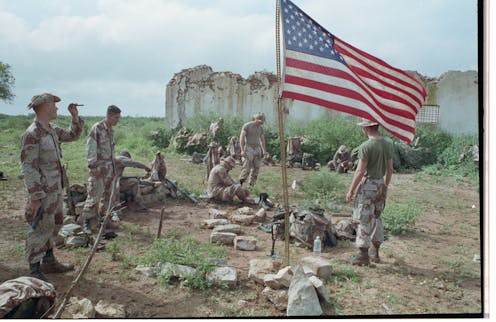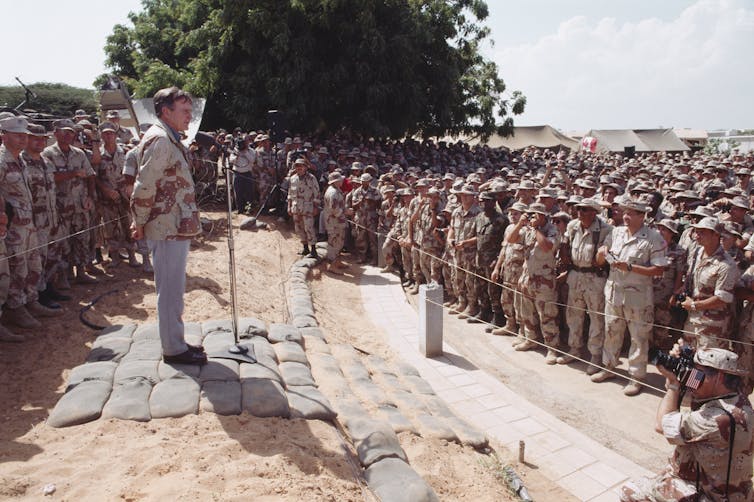
30 years after the infamous Battle of Mogadishu, the U.S. military is still conducting operations in Somalia.
Popularized in the U.S. by the 2001 film “Black Hawk Down,” the Battle of Mogadishu occurred on Oct. 3, 1993, and saw the downing of two U.S. helicopters and the deaths of 18 American soldiers. Some of their bodies were dragged along city streets by Somali militants.
The battle was considered one of the worst fiascoes in U.S. military history.
Since then, the U.S has waged economic and military warfare in Somalia to first eliminate the Union of Islamic Courts, a grassroots legal and political group, and most recently to attack the militant group al-Shabaab. There have been at least 282 U.S. counterterrorism operations in Somalia, including drone strikes and other aerial bombardments.
But its my belief as a scholar of contemporary U.S.-Somali relations that the U.S. efforts to develop political stability and eliminate terrorism has achieved the very opposite and not brought an end to political violence in the war-torn country.
In fact, al-Shabaab is still waging one of the largest and deadliest insurgencies in the world.
To meet the latest threat, President Joe Biden has increased military assaults in Somalia that target al-Shabaab insurgents, conducting dozens of airstrikes so far in 2023. In May 2022, Biden also agreed to send about 500 U.S. troops to Somalia.
In addition, the U.S. also sends advisers to train Somali security forces and maintains an active presence in neighboring Djibouti at the Camp Lemonnier base.
But the question remains: Why are U.S. forces still intervening in Somalia?
The cost of US involvement in Somalia
Between 2007 and 2020, the U.S. spent at least US$2.5 billion on counterterrorism operations in Somalia, according to Costs of War, a 2023 Brown University study. This amount was largely spent by the U.S. Department of State and does not include the unknown expenditures of the U.S. Central Intelligence Agency and U.S. Defense Department.
For comparison, between 2001 and 2022 the U.S. spent approximately $2.3 trillion, or nearly 1,000 times more, on “counterterrorism” wars in Afghanistan.
The U.S. spends time and money training the Somali National Army, assisting in surveillance and drone strike operations. Many of their activities are not publicly traceable. According to one U.S. congressional staffer who wished to remain anonymous, “even the U.S. government’s own officials do not know the total amount that has, and continues to be, spent on counterterrorism in Somalia.”
Understanding the crisis in Somalia
Located in East Africa on the coast of the Indian Ocean, Somalia is one of the poorest countries in the world.
Decades of civil war coupled with extreme droughts have caused the roughly 17 million people to exist in dire living conditions.
In 2022, about 43,000 people died from drought, while more than one million have been displaced so far just in 2023 by drought, famine and ongoing violent attacks. The nexus of climate chaos and political violence poses significant challenges for the Somali government. And yet, the counterterrorism and climate policies enacted by the Somali government continually exacerbate these problems.

In 2005, under the Bush administration, the CIA backed an unpopular and violent attempt to overthrow the Union of Islamic Courts. The group comprised about a dozen local Islamic courts in southern Somalia that solved social disputes, reopened schools and ended roadblocks erected by violent warlords.
The Union of Islamic Courts was generally popular among the Somali people living within their jurisdiction and seen by many residents as a welcomed alternative to the prior decade of civil war that decimated the region.
The US global war on terrorism
In the post-9/11 era, U.S. government officials were wary of an Islamic government coming to power in Somalia and were fearful of the Union of Islamic Courts. When the CIA’s effort failed to topple the group, the U.S. government then backed an Ethiopian military invasion of Somalia in late 2006.
During this brutal two-year invasion, many members of the Union of Islamic Courts were killed or chased out of Mogadishu, and a small group of youth began a recruitment campaign using the slogan “al-Shabaab,” or “the youth” in Arabic.
In my view, this U.S.-supported Ethiopian invasion was largely responsible for creating the conditions of political uncertainty and violence that prevail today.
Al-Shabaab portrayed the U.S.-backed Ethiopian invasion in religious and nationalist terms and painted the U.S. and Ethiopia as Christian invaders of a Muslim country.
After two years of war, Ethiopia withdrew its troops, claiming their mission to rid the extremist threat was accomplished.
This assertion proved to be false, as al-Shabaab insurgents recaptured nearly all territory lost by the UIC.
Time for a US reckoning on Somalia?
The economic harm and social devastation caused by the U.S. government is extensive, and there is little reason to believe the U.S. approach to Somalia will change in the near future.
On Sept. 6, 2023, for instance, the U.S. military reportedly provided “remote assistance” to an aerial strike operation conducted by the Somali government that killed five civilians.
Besides devastating the families left behind in the wake of violence, the lack of transparency and accountability has created an enduring tragedy for the Somali victims of the U.S.’s covert activities.
The U.S. role in Somalia does not absolve al-Shabaab of its crimes, as the militant group continues to recruit from socially and economically disenfranchised communities in Somalia. Among those crimes are bombings of civilian targets throughout Africa and the Middle East, resulting in hundreds of deaths.
But in my view, a demand for reparations from the Somali government before an international tribunal may force a U.S. reckoning on its global war against terrorism that nevertheless still rages on in Somalia.
Jason C. Mueller does not work for, consult, own shares in or receive funding from any company or organization that would benefit from this article, and has disclosed no relevant affiliations beyond their academic appointment.
This article was originally published on The Conversation. Read the original article.







